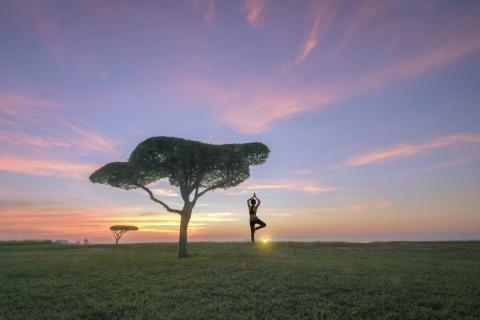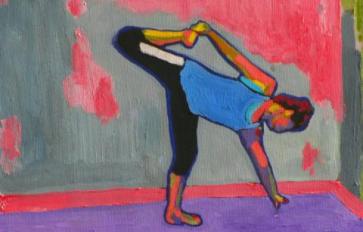
The eight limbs of yoga first appeared in ancient yoga writings, called the Patanjali's Yoga sutras. The Yoga Sutras offer an intention for living that is still relevant today. The word sutras means to thread or weave. When practiced with attention and presence they refine and stabilize every aspect of our lives.
True yoga is about self-realization, our soul’s identity with the divine. Yoga weaves together eight distinct parts progressing you in the direction of your personal growth and evolution. Rooting from the earth and reaching for the sky is the spirited tree of yoga with its eight limbs. Patanjali, the author consciously made the order of the limbs from outer to inner, to the more subtle parts of self. On our personal life path the eight limbs remind us how to be in loving relationship with self, others, and the divine within. The lower limbs anchor us. The upper limbs are of self-reflection.
The Root Of The Tree
Starting with the root of the tree is the yamas: moral disciplines or ethical standards. The yamas help us observe ourselves and others in the world. It is how we put love in action, by treating others well.
There are five yamas:
- ahimsa (non-violence)
- satya (truthfulness)
- asteya (non-stealing, “what is here is enough”)
- brahmacharya (moderation of senses)
- aparigraha (non-greed, allowing things to come and go)
The Trunk Of The Tree
The trunk of the tree are the niyamas: self-realization and self-care.
There are five niyamas:
- saucha (cleanliness, purity)
- santosha (contentment)
- tapas (commitment, or heat and igniting vitality and burning through habits, patterns that prevent you from knowing your own truth)
- svadhyaya (self-study, awareness of your own mortality)
- ishvara pranidhana (surrender to a higher power)
The Branches Of The Tree
The spirit tree’s flowing branches represent asana. Asana refers to the seat of meditation and its moving physical forms. In the sutras, asana means right poise, seat, sitting still. The only alignment instruction Patanjali gives for this asana is “sthira sukham asanam”—the posture should be steady and comfortable. The physical form of yoga came about to prepare the body for sitting still in meditation and giving way to something else—the body as temple of the spirit.
The Leaves Of The Tree
Leaves hold the healing energy of life itself. The word prana refers to energy or movement of life source. The fourth limb refers to the flow of breath in your body as well as the energy of the universe around us. Our very breath determines the quality of our lives.
Prana often describes breath, or the mechanics of your breath. Within the inner workings of the breath transport this life force of who we are today. Move through your asana with breath to encounter vitality, connection, peace, love, and forgiveness. Pranayama creates a place of calm and peace in the body and mind. Pranayama techniques become the gateway for the second set of limbs, concentration and meditation.
The Bark Of The Tree
The tree’s branches are cradled and protected by bark coinciding with pratyahara, or sense withdrawal. Pratya means to draw in and ahara means anything we are taken in by. Pratyahara is the ability to concentrate without distraction—when we no longer seek external stimuli and find a sense of peace.
The Sap Of The Tree
The sap of the tree is like the blood flowing through our veins. This limb personifies dharana, an uninterrupted flow of concentration. Intense focus and gathering attention to breath is dharana. This is the beginning of meditation and freedom in our minds. Patanjali is saying, “If you call yourself inwards, focus inward on one point: BLISS is coming.”
The Flowers Of The Tree
All the energies of the spirit tree bring the flourishing of flowers. The flowers of the tree symbolize dhyana, or meditation. Dhyana comes from the sanskrit word dhyai which means “to think of.” Existing in its natural beautiful form, some of the earliest documented forms of meditation date to 1500 BCE. The intention of meditation is to move us from outer activity to inner silence. As the expression of a quiet flower, we become quieter and quieter until it is so quiet we actually just be.
The incredible blossoms bring clarity, appreciation, and a connection to the higher spiritual self. The benefits include physical and mental health. Discover a freedom to choose how you act. Dhyana is a flowering, expansive energy connecting us to all that we want to manifest in life.
The Fruit Of The Tree
The essence of the tree is in its fruit, the final limb. Through dharana and dhyana comes bearing of the fruit samadhi, the state of oneness—the bliss dimension of our being. As we discover deeper levels of self and dissolve all boundaries, the soul can develop its highest state of consciousness.
Samadhi unfolds at the center, around the heart as pure love. Samadhi is the space beyond regular consciousness; something deeper transpires and will change your life in miraculous ways. Perhaps it is the deepest experience of who you are: this precious part of you that is natural and in union with the whole and oneness with the universe. Samadhi is available to everyone.
Samadhi ignites glowing illumination, radiance and presence. This inner presence of love can transform you in a moment. It is something each individual must try to experience on his own, letting the experience unfold naturally.
There is an awareness of life that is more than a physical presence. Pure bliss (ananda) is revealed by allowing the essence that we all are to be one with the divine (energy of the higher self). In Samadhi there is no separation, no suffering, no lack. The eighth limb inspires us to live from that place. Integrating the eighth limb into our life experiences, we live with meaning and purpose, joy and wholeness—now!
What Can You Do?
So how can we bring out the best in one’s self through the eight limbs? The outgrowth of practicing the eight limbs provides a healthier body and mind, balance and harmony. The inner efforts affect those that are near and dear to us.
Although each of the eight limbs can be practiced in order, one limb supporting the other, the Yoga Sutras tell us the eight limbs need not be mastered in any particular order. Every time you practice with the eight limbs, be intrigued. You might note that some of these can be done together. Possibly walk in solitude with attention to breath and listen to your heart.
How do we help ourselves get there? Strive to practice the eight limbs often, but not to feel guilty if you don't carry it out every day. Most of all, love yourself, not judging or punishing. With kindness and compassion for ourselves we keep going, doing the work.
This is a treasure map from Patanjali. Trust your instincts. Again and again we can view the deeper levels of our self and distill from this what is meaningful to our lives.
Bring bliss to yourself by learning more from love and less from fear and anger. In every space opened, a deeper place is cleared in which each soul can put love into action. Live with passion and purpose. Create your own bliss right here, right now. Bliss to your mind, to your body, to your breath and to your heart. Blissful!








